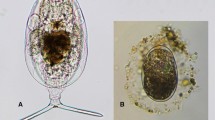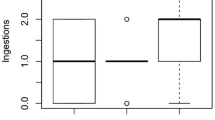Summary
Keratella cochlearis exhibited consistent seasonal abundance patterns during a four-year study in Little Rock Lake, Wisconsin, U.S.A. In each year, spring population peaks were followed by strong summer reductions. Concomitant with population declines, there were reductions in rotifer egg ratios. Keratella taurocephala abundance patterns were similar to those of K. cochlearis during 1984 and 1985, but not in 1986 and 1987, when spring peaks and summer declines were not apparent. However, summer declines in the egg ratio of K. taurocephala were observed during each year. The reduction in rotifer populations simultaneously with decreased egg ratios suggested that population declines were caused by food limitation. Food-addition experiments conducted in situ in small enclosures indicated that food was limiting for K. cochlearis when its populations were declining, but not during other periods of the year. Keratella taurocephala did not show a consistent response to food addition.
Similar content being viewed by others
References
Baker R (1979) Birth rate of planktonic rotifers in relation to food concentration in a shallow eutrophic lake in Western Canada. Can J Zool 57:1206–1214
Bogdan KG, Gilbert JJ, Starkweather PL (1980) In situ clearance rates of planktonic rotifers. Hydrobiologia 73:73–77
Burns CW, Gilbert JJ (1986a) Effects of daphnid size and density on interference between Daphnia and Keratella cochlearis. Limnol Oceanogr 31:848–858
Burns CW, Gilbert JJ (1986b) Direct observations of the mechanisms of interference between Daphnia and Keratella cochlearis. Limnol Oceanogr 31:859–866
Brezonik PL, Baker LA, Eaton JR, Frost TM, Garrison P, Kratz TK, Magnunson JJ, Perry JA, Rose WJ, Shepard BK, Swenson WA, Watras CJ and Webster KE (1986) Experimental Acidification on Little Rock Lake, Wisconsin. Water, Air & Soil Pollution 31:115–121
Comita GW (1972) The seasonal zooplankton cycles, production and transformations of energy in Severson Lake, Minnesota. Arch Hydrobiol 70:14–66
Cushing DH (1976) Grazing in Lake Erken. Limnol Oceanogr 21:349–356
De Bernardi R (1974) The dynamics of a population of Daphnia hyalina, Leydig in Lago Maggiore, Northen Italy. Mem Ist Ital Idrobiol 31:221–243
Dodson SI (1974) Adaptative changes in plankton morphology in response to size-selective predation: A new hypothesis of cyclomorphosis. Limnol Oceanogr 19:721–729
Downing JA, Peters RH (1980) The effect of body size and food concentration on the in situ filtering rate of Sida crystalina. Limnol Oceanogr 25:883–395
Edmondson WT (1965) Reproductive rate of planktonic rotifers as related to food and temperature. Ecol Monogr 35:61–111
Edmondson WT (1977) Population dynamics and secondary production. Arch Hydrobiol Beih Ergebn Limnol 8:56–65
Federenko AY (1975) Instar and species-specific diets in two species of Chaoborus. Limnol Oceanogr 20:238–248
Foran JA, King RH (1982) A regression analysis of the summer population dynamics of Polyarthra vulgaris in a Northern Michigan U.S.A. bog lake. Hydrobiologia 94:237–246
Frost TM, Montz PK (1988) Early zooplankton response to experimental acidification in Little Rock Lake, Wisconsin, U.S.A. Verh Int Verein Limnol 23:2279–2285
Gilbert JJ, Williamson CE (1978) Predator-Prey Behavior and Its Effect on Rotifer Survival in Associations of Mesocyclops edax, Asplanchna girodi, Polyarthra vulgaris, and Keratella cochlearis. Oecologia 37:13–22
Gilbert JJ, Stemberger RS (1985) Control of Keratella population by interference competition from Daphnia. Limno Oceanogr 30:180–188
Gilbert JJ (1989) Susceptibilities of ten rotifer species to interference from Daphnia. Ecology 69:1826–1838
Goldman CR, Morgan MD, Threlkeld ST, Angeli N (1979) A population dynamics analysis of the cladocerans disappearance from Lake Tahoe, California-Nevada. Limnol Oceanogr 24:289–297
Guillard RL (1975) Culture of phytoplankton for feeding marine invertebrates. In: Smith WL and MH Chanley (eds) Culture of Marine Invertebrates Animals, Plenum N. Y., pp 29–56
Hall DJ (1971) Predator-prey relationships between yellow perch and Daphnia in a large temperate lake. Transactions American Microscopical Society 90:106–107
Lampert W (1978) A field study on the dependence of the fecundity of Daphnia spec. on food concentration. Oecologia 36:363–369
Lampert W, Fleckner W, Rai H, Taylor BE (1986) Phytoplankton control by grazing zooplankton: A study on the spring clearwater phase. Limnol Oceanogr 31:478–490
Larsson P, Andersen S, Borsheim Y, Jakobsen P, Johnsen G (1985) Individual growth of Daphnia longispina in the summer decline phase of the population. Arch Hydrobiol Beih Ergebn Limnol 21:341–350
McMahon JW, Rigler FH (1963) Mechanisms regulating the feeding rate of Daphnia magna Straus. Can J Zool 41:321–332
McNaught DC (1975) A hypothesis to explain the succession from calanoids to cladocerans during cutrophication. Verh Internat Verein Limnol 19:724–731
Muck P, Lampert W (1984) An experimental study on the importance of food conditions for the relative abundance of calanoid copepods and cladocerans. Arch Hydrobiol/Suppl. 66 (Arbeiten Limnol. Inst. Univ. Konstanz 13) 2:157–179
Neill W (1984) Regulation of rotifer densities by crustacean zooplankton in a oligotrophic montane lake in British Columbia. Oecologia 55:175–181
Petersen F (1983) Population dynamics and production of Daphnia galeata (Crustacea, Cladocera) in Lake Esrom. Holartic Ecology 6:285–294
Porter KG, Gerritsen J, Orcutt JD (1982) The effect of food concentration on swimming patterns, feeding behavior, ingestion, assimilation, and respiration by Daphnia. Limnol Oceanogr 27:935–949
Prepas E (1978) Sugar-frosted Daphnia: An improved fixation technique for Cladocera. Limnol Oceanogr 23:557–559
Schneider DW (1990) Direct assessment of the independent effects of exploitative and interference competition between Daphnia and rotifers. Limnol Oceanogr 35:916–922
Sierszen ME (1990) Variable selectivity and the role of nutritional quality in food selection by a planktonic rotifer. Oikos 59:241–247
Sierszen ME, Frost TM (1990) Effects of an experimental lake acidification on zooplankton feeding rates and selectivity. Can J Fis Aquat Sc 47:772–779
Sokal RR, Rohlf FJ (1981) Biometry. W.H. Freeman and Co, N.Y.
Sprules WG (1972) Effects of size selective predation and food competition on high altitude zooplankton communities. Ecology 53:375–386
Stemberger RS, Gilbert JJ (1984) Spine development in the rotifer Keratella cochlearis: induction by cyclopoid copepods and Asplanchna. Freshwater Biology 14:639–647
Stemberger RS, Gilbert JJ (1985) Body size, food concentration and population growth in planktonic rotifers. Ecology 66:1151–1159
Tessier A (1986) Comparative population regulation of two planktonic Cladocera (Holopedium gibberum and Daphnia catawba). Ecology 67:285–302
Threlkeld S (1979) The midsummer dynamics of two Daphnia species in Wintergreen Lake, Michigan. Ecology 60:165–179
Threlkeld S (1985) Resource variation and the initiation of midsummer declines of cladoceran populations. Arch Hydrobiol Beih Ergebn Limnol 21:333–340
Vanni MJ (1987) Effects of food availability and fish predation on a zooplankton community. Ecol Monogr 57:61–88
Watras CJ, Frost TM (1989) Little Rock Lake: Perspective on an experimental, ecosystem approach to seepage lake acidification. Arch Environ Contam Toxicol 18:157–165
Williamson CE (1983) Invertebrate predation on planktonic rotifers, Hydrobiologia 104:385–396
Williamson CE (1984) Laboratory and field experiments on the feeding ecology of the cyclopoid copepod, Mesocyclops edax. Freswater Biology 14:575–585
Author information
Authors and Affiliations
Rights and permissions
About this article
Cite this article
González, M.J., Frost, T.M. Food limitation and seasonal population declines of rotifers. Oecologia 89, 560–566 (1992). https://doi.org/10.1007/BF00317164
Received:
Accepted:
Issue Date:
DOI: https://doi.org/10.1007/BF00317164




